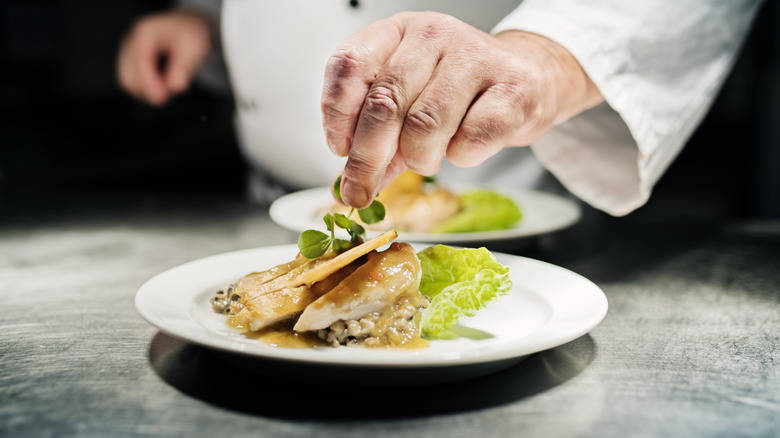Why Some Chefs Refuse To Order Chicken When They Go Out To Eat
When you're going out for dinner, there are a number of different factors that you need to take into account. These considerations vary in importance — for example, a delicious dinner will obviously be overshadowed if you contract food poisoning from the meal. You also need to take into account the restaurant you're dining at, and which plates it prides itself on.
If you have any cooking experience, you'll know how easy it is to make mistakes with raw chicken. Taking both a sanitary stance and expressing a protein preference, some chefs have cut chicken out from their restaurant orders altogether when they dine out. This is not a new phenomenon. In fact, the late Anthony Bourdain expressed his aversion to ordering poultry plates in a 1999 article he wrote for The New Yorker. In the piece, he shines a light on the entire restaurant industry but specifically singles out chicken, which he feels is flavorless and generally overlooked by chefs. He also highlights the hazards associated with contaminated chicken.
Chefs talk turkey about chicken
In Anthony Bourdain's experience, restaurant menus are often filled with a slew of uninspired chicken dishes, made to satisfy the desires of indecisive customers. In the aforementioned New Yorker piece, Bourdain explains that the culinary community has come to a consensus that chicken is less flavorful in the United States, and well-traveled American cooks balk (or rather, bawk) at the bland birds that are served stateside.
Chefs have taken notice of the fact that restaurant chicken is almost always overlooked. The consensus of the culinary community on chicken seems to err on the side of caution. If a restaurant serves only basic, bland chicken breast with its succulent skin stripped off, you're probably better off ordering a different dish. One good way to work out if a restaurant serves a chicken dish worth its salt is to simply ask the eatery's waitstaff their opinion of the chicken — if your server can't provide details on the dish's preparation, that should also be a red flag. On the other hand, if the chicken takes a brine bath, "for 18 hours in lemon, rosemary, and a decent amount of sea salt" (via Bon Appétit) like the roasted bird that chef David Honeysett serves up at Raoul's, a beloved Manhattan restaurant, you shouldn't automatically opt out of ordering the chicken.
Chicken can also cause contamination
It's clear that chefs find restaurant chicken to be both bland and bone-dry. However, the most compelling argument against ordering chicken is not flavor-focused but rather pertains to the meat's contamination risks. The CDC tells us that around one million Americans fall ill from contaminated poultry products annually. While there are some obvious signs your chicken has gone bad, handling chicken is incredibly particular. It involves repeated hand washing and an awareness of what kitchen utensils the chicken has touched to avoid cross-contamination, and even after all these steps, a chef still needs to cook the chicken to 165 degrees Fahrenheit.
Professional cooks have to go through this painstaking process many times on a daily basis, which might help explain why seasoned chefs can overlook some safety precautions. A CDC investigation carried out from 2017 to 2019 found that 40 percent of food-related illness outbreaks could be tied to sick workers coming into contact with food. This is a good reason for you to try your hand at making restaurant-quality fried chicken at home. Just make sure you wash your hands!


